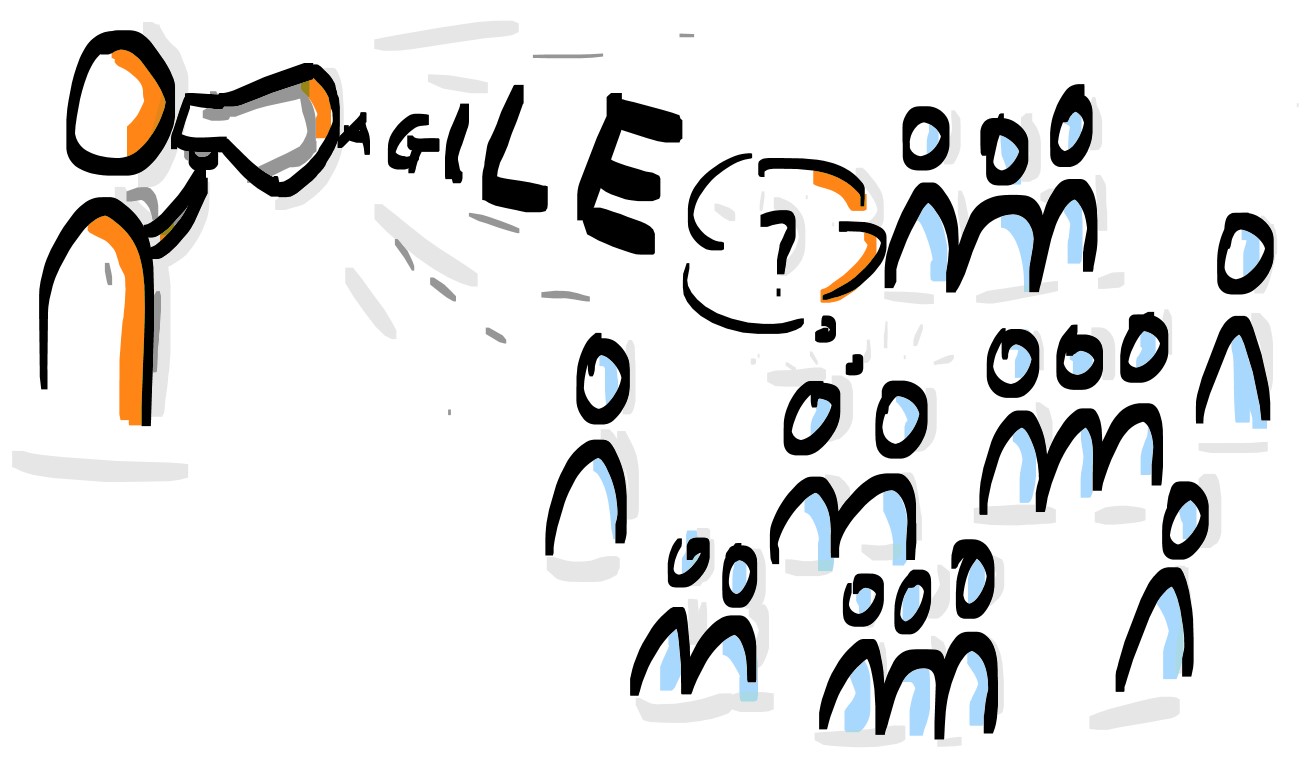You want to work agile? You are expected to do so? You start working with Scrum or try your hand at Management Y? Remember: You are not just introducing methods.
Agility promises a lot, and rightly so
- Results are achieved faster and better, customer wishes, their practicability and company goals are brought together in a very good way
- The staff’s expertise is used to the maximum, motivation increases.
- The organisation becomes flexible and fast.
- Customers, employees and suppliers become more satisfied.
- The methods and instruments are comprehensible, catchy and easy to introduce.

So the advantages are obvious. Nonetheless, why is it sometimes so difficult to move towards Agile?
Sounds good! That’s what we do!
People and organisations often want to change when they are dissatisfied: We are less good than we want to be and can be, we are too inflexible, too slow too inefficient.
When looking for solutions, agile methods are increasingly coming under consideration. Yet in the expectant tunnel vision of process improvement, one important detail is often overlooked:
Agile is linked to a certain understanding of organisation, which is crucial for the effectiveness and success of the methods
He who says “A”…
Responsibility
Everyone has a stake in the success of the project or venture and wants to take responsibility for it. It is necessary that they are allowed to take on responsibility and do so. Generally within the scope of their possibilities, but especially within the scope of their roles.
Motivation, trust & control
Everyone is intrinsically motivated to devote all their resources to the common cause. Accordingly, trust is emphasised and control is treated as a lower priority.
Randnote: Control in the sense of checking the results is seen as an important organisational task, for which the group and not the individual is responsible, e.g. a manager.
Error culture
There is no way to make accurate predictions, uncertainties exist. Therefore, mistakes cannot be entirely avoided. Mistakes are positive, because that is the only way to learn and improve. Mistakes are carried by everyone, the whole organisation learns from them.
Because the Agile worldview recognises that this is the reality of life anyway and without alternative for the time being.
Value creation & success
Not only arithmetical values are decisive, also qualitative things are meaningful and value-adding (e.g. customer and employee satisfaction and learning success).
Side note: To ensure that agile organisations do not also run the risk of letting this wither away to an empty postulate, this is woven into the agile structure as a structural element, e.g. in the corresponding role perceptions or the feedback methodology.
These examples make obvious that Agile is undergoing a comparatively strong shift of values: Corporate goals and the ways to achieve them are being defined differently than before.
So it is only consistent that in the agile environment many of the “conventional” structures and management methods not only contribute less to good results, they actually prevent them.

In concrete terms, this means, for example
… that despite an agreed Agile process, diplomatic-political interferences take place, role definitions are softened by means of tactical-political gimmicks or priorities are shifted outside the responsible bodies.
If this is allowed to continue, all hoped-for positive results are in danger. For the result is inevitably massive conflicts that lead far away from the goal of smooth and result-oriented processes.
Whoever wants to successfully (!) remedy problems with the help of Agile, can therefore no longer avoid making the change on two levels: Structures are to be created by using Agile methods.
At the same time, it is important to integrate Agile values by living them. This applies to every change, of course. But perhaps especially in the case of an agile change.
…sometimes doesn’t say “B”
Of course it is possible to use Agile tools without adopting the mindset that lies beneath them. However, this can lead to conflicts, which not only prevent the desired smooth and solution-oriented processes in the short and medium term, but also prevent problems from being solved and better results from being achieved.
These conflicts can also become a risky test for teams, departments and entire organisations and lead them into dangerous imbalances.
To avoid this, it’s best not to fall for the lure of agile methodology in the first place. Instead, honestly ask yourself whether Agile beliefs and values apply to you and others around you, or might apply in the near future.
- Are you, your bosses, employees, colleagues, customers and suppliers (!) willing to relinquish control, have trust in individuals and group decisions, establish an appropriate culture of error, give up privileges and status, etc.?
- Are you really ready to say not only “A” but also “B” and become an Agile organisation?
Only then: Go for it! Because then it will be worth it.

 To avoid this, it’s best not to fall for the lure of agile methodology in the first place. Instead, honestly ask yourself whether Agile beliefs and values apply to you and others around you, or might apply in the near future.
To avoid this, it’s best not to fall for the lure of agile methodology in the first place. Instead, honestly ask yourself whether Agile beliefs and values apply to you and others around you, or might apply in the near future.